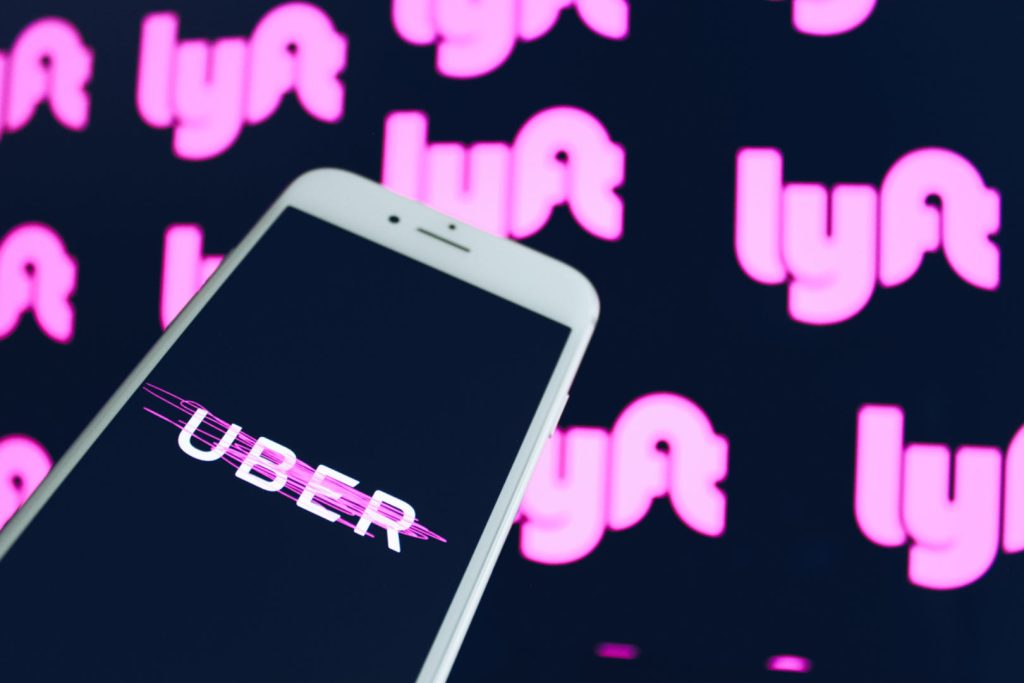Uber & Lyft: The Successes and Challenges of the Sharing Economy Model
Nowadays, the sharing economy has changed the way we travel. The rise of the sharing economy model has changed the status quo of urban transportation, improving the accessibility and flexibility of urban travel, such as the rise of two sharing platforms, Uber and Lyft. However, such a sharing economy model has sparked a fierce debate about social justice and labor rights,which highlights the significant concerns and challenges of human life under the sharing economy model.
Does the sharing economy model really benefit mankind, or is it a deep trap?

“Uber Lyft” by Stock Catalog is licensed under CC BY-ND 2.0
Sharing economy background
“People are starting to consume collaboratively, band together to trade, share and negotiate better deals with retailers, not for reasons related to the technology landscape, but because of the economy and the environment.” (John, 2016)
The sharing economy is a business model in which resources (such as vehicles, accommodation, skills, etc.) are now shared with others through online platforms, in another way, people return to an older but better way of life.
“Social media and ICTs not only enable collaborative consumption, but actually drive it.” (John, 2016) Social media and information and communication technologies make it easier for people to share and collaborate on the use of resources together, and have also encouraged people to adopt this collaborative consumption model more actively. In other words, these technologies have made sharing and collaboration a trend and pushed people to participate in the sharing economy more frequently. For example, some people use item-sharing platforms such as Turo, Getaround to rent their items such as tools, bikes, cars, and home equipment for extra income. They can profit from these sharing platforms, thus people are willing and active participants in the sharing economy.
Therefore, its development has expanded rapidly over the past decade, with Uber and Lyft among the leaders. The two platforms connect drivers and passengers, providing a convenient way for people to get around.
The benefits of the sharing economy model are widely felt.
Increased accessibility
Uber and Lyft have significantly improved mobility accessibility in cities by providing anytime, anywhere mobility options. Studies have shown that this can be especially beneficial for those who do not own a personal car or have difficulty driving. According to the New York City Regional Plan Association, the two companies have expanded travel options, making public transportation and ride-sharing services more accessible to more people(Aarian, 2017).

“Busy in Every Way” by Brando is licensed under CC BY-ND 2.0
Reducing the need for private car ownership
The presence of Uber and Lyft reduces the need for individuals to own private cars, thereby reducing car congestion and carbon emissions on urban roads. Ride-sharing services can reduce the number of private cars, especially in urban areas. This has helped to improve traffic congestion to some extent and reduce the adverse impact on the environment.
However, this claim needs to be examined more closely. The operating models of Uber and Lyft could adversely affect urban transportation. A large number of drivers waiting for orders on urban roads will lead to traffic congestion and waste of resources, which will reduce the efficiency and accessibility of travel (Emma&Winnie, 2017).
Create economic opportunity
These two platforms provide additional income opportunities for thousands of drivers. This is an attractive option for those who need flexible working hours. According to a report by Uber, more than 90 percent of drivers say they choose Uber because of the flexibility in their working hours, which provides many with financial stability (Jessica, 2017). Actually, Uber revolutionized the shift in taxi ownership from a transportation company to a private owner of a taxi, so that everyone can effectively act as a transportation owner and have flexible working hours.(Yunus, Susilo, Riyadi, Indrasari & Putranto, 2019).
When we discuss how the sharing economy is changing the way people travel, we can see some positive aspects. The rise of sharing platforms such as Uber and Lyft has brought greater flexibility and accessibility to urban mobility, which is undoubtedly a convenience for many people.
However, this sharing economy model also faces very profound problems and challenges.
Labor rights issue
Some skeptics see it as an unregulated and exploitative system that allows people to work without the protections and social rights that employees are entitled to. (John, 2016)
According to video content and research by the Economic Policy Institute, the average independent contractor typically earns less than the average salary of a permanent employee. (Lawrence, 2018)
This means that while Uber and Lyft tout that drivers can work as much as they want, in reality, many drivers remain low-income and lack stable financial security. This low pay takes a heavy toll on the finances of drivers, who often play a key role in the success of these companies.
Classifying drivers as independent contractors also allows Uber and Lyft to circumvent some labor regulations, such as minimum wage regulations and overtime pay. Platformization has impacted the entire industry, effectively blurring the lines between private and public transportation modes. (José, 2018) This exacerbates labor rights issues and puts drivers at a disadvantage when it comes to labor law protections. The practice raises serious labor rights concerns and puts many drivers at risk of exploitation and unfair treatment.
Social inequality
Notably, the rise of the so-called “sharing economy” has given rise to new competition in many industries, The emergence and popularity of ride-sharing such as Uber and Lyft has had a huge impact on the traditional taxi industry. Taxi drivers are typically required to comply with city regulations, pay licensing fees, and comply with a host of regulatory requirements. (Georgios, 2016) For example, ride-sharing platforms often use dynamic pricing models that adjust prices according to supply and demand during peak traffic hours or special events, which also allows platforms to sometimes raise prices during periods of high demand. This price fixing results in high fees paid by passengers, who do not have the price regulation of the traditional taxi industry, which faces an uneven playing field.(José, 2018) In contrast, drivers on ride-sharing platforms are often able to bypass these regulations, creating an uneven playing field. (Scott, 2015)Traditional taxi drivers are often hit with a double whammy, both losing passengers and having to continue to comply with strict regulations. This business model has already threatened and disadvantaged the traditional taxi industry, and even threatened existing businesses across the economy.
Read more: Is the economic model of shared mobility a liberation or a trap? https://farapaper.com/wp-content/uploads/2022/08/Fardapaper-The-Competitive-Effects-of-the-Sharing-Economy-How-is-Uber-Changing-Taxis.pdf: Is the economic model of shared mobility a liberation or a trap?Meanwhile, the dynamic pricing policies of ride-sharing platforms mean that prices may surge during periods of high demand. This also leads to an uneven ride experience, as people with higher incomes are more able to pay higher prices, while people with lower incomes may be excluded from rush-hour travel options. This dynamic pricing policy has led to unequal access to travel, which is also unfair to travelers. For the current situation of this problem, the New South Wales government has taken relevant measures to stop.
“Lyft @ SXSW 2016” by Nrkbeta is licensed under CC BY-ND 2.0
The sharing economy, which is undoubtedly an important innovation for those who need convenient mobility options. Ride-sharing platforms like Uber and Lyft have increased mobility accessibility in cities, reduced private car ownership, and created many jobs, giving people the flexibility to earn extra income has improved quality of life in some ways. But in fact, it can not be ignored is the labor problems they face, social inequality problems lead to some drivers may fall into the plight of low income, not fair employee welfare protection and so on.
In conclusion, the sharing economy model does have its merits in terms of providing convenience and job opportunities, but it must also seriously address labor issues and social inequalities. Only if the balance is found and appropriate regulatory measures are adopted, can the sharing economy truly liberate people and bring greater benefits to society.
Bibliography:
José, V. ,(2018). Urban Transport. In Oxford University Press eBooks. https://doi.org/10.1093/oso/9780190889760.003.0005
John, N. ,(2016). Sharing Economics. In: The Age of Sharing. polity; lviii-lxxvii. Login.ezproxy.library.sydney.edu.au. https://ebookcentral-proquest-com.ezproxy.library.sydney.edu.au/lib/usyd/detail.action?docID=4770940.
Aarian,M., (2017), The Secret Uber Data That Could Fix Your Commute. https://www.wired.com/2017/02/ubers-coughing-data-nyc-fix-commute/
Jessica,(2015),New Survey: Drivers Choose Uber for its Flexibility and Convenience, https://www.uber.com/newsroom/driver-partner-survey/
Emma G. F, & Winnie, H. ,(2017, March 6). The Downside of Ride-Hailing: More New York City Gridlock. The New York Times. https://www.nytimes.com/2017/03/06/nyregion/uber-ride-hailing-new-york-transportation.html
Lawrence, M. ,(2018, May 15). Uber and the labor market: Uber drivers’ compensation, wages, and the scale of Uber and the gig economy. Economic Policy Institute. https://www.epi.org/publication/uber-and-the-labor-market-uber-drivers-compensation-wages-and-the-scale-of-uber-and-the-gig-economy/
Georgios, P., (2016, February 22). Uber and the economic impact of sharing economy platforms. Bruegel | the Brussels-Based Economic Think Tank. https://www.bruegel.org/blog-post/uber-and-economic-impact-sharing-economy-platforms
Aarian, M., (2017). NYC’s Making Uber Cough Up More Data—And It Could Fix Your Commute. Wired. https://www.wired.com/2017/02/ubers-coughing-data-nyc-fix-commute/
Scott, W. ,(2015). The competitive effects of the sharing economy: how is Uber changing taxis. Technology Policy Institute, 22(3). https://farapaper.com/wp-content/uploads/2022/08/Fardapaper-The-Competitive-Effects-of-the-Sharing-Economy-How-is-Uber-Changing-Taxis.pdf
Sainato, M. (2023, March 10). “It was traumatic”: Uber, Lyft drivers decry low pay and unfair deactivations. The Guardian. https://www.theguardian.com/business/2023/mar/10/uber-lyft-driver-suspension-deactivation-pay
Scott, G. (2020, October 3). Sharing Economy: Model Defined, Criticisms, and How It’s Evolving. Investopedia. https://www.investopedia.com/terms/s/sharing-economy.asp
Walter, M. (2020). Turo: the Airbnb for Cars. Digital Innovation and Transformation. https://d3.harvard.edu/platform-digit/submission/turo-the-airbnb-for-cars/
Leal, L. (2019). Getaround’s platform: A vision of a world where all cars are shared. Digital Innovation and Transformation. https://d3.harvard.edu/platform-digit/submission/getarounds-platform-a-vision-of-a-world-where-all-cars-are-shared/
Uber.com, (n,d), How surge pricing works. https://www.uber.com/au/en/drive/driver-app/how-surge-works/
Yunus, E., Susilo, D., Riyadi, S., Indrasari, M., & Putranto, T. D. (2019). The effectiveness marketing strategy for ride-sharing transportation: intersecting social media, technology, and innovation. Entrepreneurship and Sustainability Issues, 7(2), 1424–1434. https://doi.org/10.9770/jesi.2019.7.2(44)




Be the first to comment on "Is the economic model of shared mobility a liberation or a trap?"